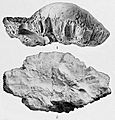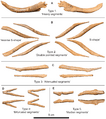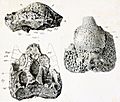Stegoceras facts for kids
Quick facts for kids StegocerasTemporal range: Late Cretaceous
|
|
|---|---|
 |
|
| Two reconstructed S. validum skeletons, Royal Tyrrell Museum | |
| Conservation status | |
|
Fossil
|
|
| Scientific classification | |
| Kingdom: | |
| Phylum: | |
| Class: | |
| Superorder: | |
| Order: | |
| Infraorder: | |
| Family: | |
| Genus: |
Stegoceras
Lambe, 1902
|
| Species: |
S. validum
|
| Binomial name | |
| Stegoceras validum |
|
Stegoceras was a small, plant-eating dinosaur that had a large, thick-skulled head. This dinosaur may have butted heads with others of its kind in bone-shaking contests. Many Stegoceras and other pachycephalosaur fossils have been found in Alberta, Canada, and Montana, USA.
Description
Stegoceras was a herding dinosaur that lived in small groups in coastal and upland regions. Running was probably its first line of defense. Stegoceras lived during the late Cretaceous period, toward the end of the Mesozoic Era, the Age of Reptiles, about 76-65 million years ago. Stegoceras was first found in 1889.
Experiments on models
Images of the insides of Stegoceras' fossilised skull showed two layers of dense bone that encase a spongy sinus held apart by tiny struts, has led some scientists to doubt this interpretation.
Computer tomographic (CT) scans on the skulls of Stegoceras, along with a variety of modern animals were used to create 3D models of the animals' heads. The team was then able to exert virtual stresses to test how the different skulls held up.
Compared to some of today's big hitters, such as the Northern American bighorn sheep, Stegoceras' head was able to withstand the most stress.
Images for kids
-
Partial dome CMN 515, lectotype of S. validum, shown from the right and underside
-
Cast of S. validum UALVP 2, the first complete pachycephalosaur skull
-
Life restoration of S. validum, with integument based on other small ornithischian dinosaurs
-
The Dinosaur Park Formation in Alberta, Canada, where S. validum was first discovered
See also
 In Spanish: Stegoceras para niños
In Spanish: Stegoceras para niños















